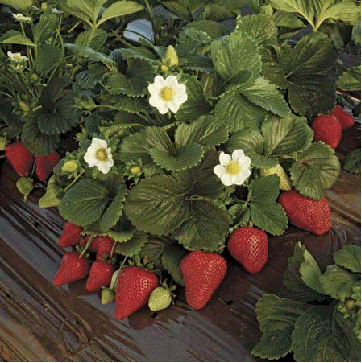|
Q. I
have a question on gardening that maybe you can help me with. My
strawberry plants produce great plants, but very little fruit. I was
told I was feeding them too much, but that's not the case because I
didn't fertilize them at all. I have tried different varieties but I
always get the same result. Thank you for your help.
A. Strawberries
are a popular berry this time of year. From pick-your-own farms to
festivals, it's strawberry time here. It's hard to top the taste of a
sweet, ripe strawberry. There are three different types of
strawberries. The most familiar kind is known as June bearing. This
type produces its one, large crop of fruit in June. Everbearing
varieties produce a large crop of berries in June and then a  smaller
one in late summer or early autumn. Day neutral strawberries produce
fruit all season long. They produce fruit buds regardless of day
length and continue to produce flowers and fruit throughout most of
the season. smaller
one in late summer or early autumn. Day neutral strawberries produce
fruit all season long. They produce fruit buds regardless of day
length and continue to produce flowers and fruit throughout most of
the season.
For strawberries that aren't bearing well, as long as you have a
productive variety that is suited to your soil and climate, it might
help to fertilize and water the bed on a regular basis. This spring
has been pretty dry with not a lot of rainfall. The tastiest berries
are produced when the plants are adequately watered and regularly
fertilized. Also strawberry plants produce the most fruit when grown
in full sun.
If the strawberry bed is crowded, it may need some thinning of the
older, unproductive plants. Strawberry beds need to be renovated
every couple of years so there is always a good batch of healthy,
young plants. To help rejuvenate the bed, select runners from each
plant. Place a pot of soil beneath the small plantlet at the end of
the runner. Pin the stem in place with a piece of bent wire and allow
the plantlet to root. Once it has rooted, cut it away from the mother
plant. This new young strawberry plant can then be planted in the bed
in place of an older, less productive one. Do this every year to
always have young plants in the bed. Regularly remove older plants
and replace them with young, healthy ones to ensure a good crop of
berries every year. |




 One
of the most easiest roses for here in western Massachusetts is
One
of the most easiest roses for here in western Massachusetts is 
 Miniature
roses are hardier than hybrid tea roses because they are growing on
their own roots. They don't have a bud union which is the most
vulnerable part of a rose bush. One of the best climbing miniature
roses is
Miniature
roses are hardier than hybrid tea roses because they are growing on
their own roots. They don't have a bud union which is the most
vulnerable part of a rose bush. One of the best climbing miniature
roses is 
 'Rainbow's
End'
'Rainbow's
End'
 by
Pernell Gerver
by
Pernell Gerver smaller
one in late summer or early autumn. Day neutral strawberries produce
fruit all season long. They produce fruit buds regardless of day
length and continue to produce flowers and fruit throughout most of
the season.
smaller
one in late summer or early autumn. Day neutral strawberries produce
fruit all season long. They produce fruit buds regardless of day
length and continue to produce flowers and fruit throughout most of
the season. Pernell
Gerver, Horticultural Communication Services All rights reserved.
Pernell
Gerver, Horticultural Communication Services All rights reserved.